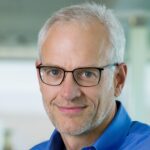|
|
 Tom Emmons, Hugh Holbrook, and Hardev Singh presented for Arista at AI Field Day 5 |
This Presentation date is September 13, 2024 at 9:30-11:00.
Presenters: Hardev Singh, Hugh Holbrook, Tom Emmons
The AI Landscape and Arista’s Strategy for AI Networking
Watch on YouTube
Watch on Vimeo
 Arista’s presentation at AI Field Day 5, led by Hardev Singh, General Manager of Cloud and AI, delved into the evolving AI landscape and Arista’s strategic approach to AI networking. Singh emphasized the critical need for high-quality network infrastructure to support AI workloads, which are becoming increasingly complex and demanding. He introduced Arista’s Etherlink AI Networking Platforms, highlighting their consistent network operating system (EOS) and management software (Cloud Vision), which provide seamless integration and high performance across various network environments. Singh also discussed the shift from traditional data centers to AI centers, where the network’s backend connects GPUs and the frontend integrates with traditional data center components, ensuring a cohesive and efficient AI infrastructure.
Arista’s presentation at AI Field Day 5, led by Hardev Singh, General Manager of Cloud and AI, delved into the evolving AI landscape and Arista’s strategic approach to AI networking. Singh emphasized the critical need for high-quality network infrastructure to support AI workloads, which are becoming increasingly complex and demanding. He introduced Arista’s Etherlink AI Networking Platforms, highlighting their consistent network operating system (EOS) and management software (Cloud Vision), which provide seamless integration and high performance across various network environments. Singh also discussed the shift from traditional data centers to AI centers, where the network’s backend connects GPUs and the frontend integrates with traditional data center components, ensuring a cohesive and efficient AI infrastructure.
Singh highlighted the rapid advancements in network speeds and the increasing demand for high-speed ports driven by AI workloads. He noted that the transition from 25.6T to 51.2T ASICs has been the fastest in history, driven by the need to keep up with the performance of GPUs and other accelerators. Arista’s Etherlink AI portfolio includes a range of 800-gig products, from fixed and modular systems to the flagship AI spines, capable of supporting large-scale AI clusters. Singh emphasized the importance of load balancing and power efficiency in AI networks, noting that Arista’s solutions are designed to optimize these aspects, ensuring reliable and cost-effective performance.
The presentation also touched on the challenges of power consumption and the innovations in optics technology to address these issues. Singh discussed the transition to 800-gig and 1600-gig optics, highlighting the benefits of linear pluggable optics (LPO) in reducing power consumption and cost. He provided insights into the future of AI networking, including the potential for even higher-density racks and the need for advanced cooling solutions to manage the increased power and heat. Overall, Arista’s strategy focuses on providing robust, scalable, and efficient networking solutions to meet the growing demands of AI workloads, ensuring that their infrastructure can support the rapid advancements in AI technology.
Personnel: Hardev Singh
AI Network Challenges & Solutions with Arista
Watch on YouTube
Watch on Vimeo
 Hugh Holbrook, Chief Development Officer at Arista, presented on the unique challenges and solutions associated with AI networking at AI Field Day 5. He began by highlighting the rapid growth of AI models and the increasing demands they place on network infrastructure. AI workloads, particularly those involving large-scale neural network training, require extensive computational resources and generate significant network traffic. This traffic is characterized by high bandwidth, burstiness, and synchronization, which can lead to congestion and inefficiencies if not properly managed. Holbrook emphasized that traditional data center networks are often ill-equipped to handle these demands, necessitating specialized solutions.
Hugh Holbrook, Chief Development Officer at Arista, presented on the unique challenges and solutions associated with AI networking at AI Field Day 5. He began by highlighting the rapid growth of AI models and the increasing demands they place on network infrastructure. AI workloads, particularly those involving large-scale neural network training, require extensive computational resources and generate significant network traffic. This traffic is characterized by high bandwidth, burstiness, and synchronization, which can lead to congestion and inefficiencies if not properly managed. Holbrook emphasized that traditional data center networks are often ill-equipped to handle these demands, necessitating specialized solutions.
One of the primary challenges in AI networking is effective load balancing. Holbrook explained that AI servers typically generate fewer, but more intensive, data flows compared to traditional servers, making it difficult to evenly distribute traffic across the network. Arista has developed several solutions to address this issue, including congestion-aware placement of flows and RDMA-aware load balancing. These methods aim to ensure that traffic is evenly distributed across all available paths, thereby minimizing congestion and maximizing network utilization. Additionally, Arista has explored innovative architectures like the distributed Etherlink switch, which sprays packets across multiple paths to achieve even load distribution.
Holbrook also discussed the importance of visibility and congestion control in AI networks. Monitoring AI traffic is challenging due to its high speed and distributed nature, but Arista offers a suite of tools to provide deep insights into network performance. Congestion control mechanisms, such as priority flow control and ECN marking, are essential to prevent packet loss and ensure smooth operation. Holbrook highlighted the role of the Ultra Ethernet Consortium in advancing Ethernet technology to better support AI and HPC workloads. He concluded by affirming Ethernet’s suitability for AI networks and Arista’s commitment to providing robust, scalable solutions that cater to both small and large-scale deployments.
Personnel: Hugh Holbrook
AI Networking Visibility with Arista
Watch on YouTube
Watch on Vimeo
 In the presentation at AI Field Day 5, Tom Emmons, the Software Engineering Lead for AI Networking at Arista Networks, discussed the challenges and solutions related to AI networking visibility. Traditional network monitoring strategies, which rely on interface counters and packet drops, are insufficient for AI networks due to the high-speed interactions that occur at microsecond and millisecond intervals. To address this, Arista has developed advanced telemetry tools to provide more granular insights into network performance. One such tool is the AI Analyzer, which captures traffic statistics at 100-microsecond intervals, allowing for a detailed view of network behavior that traditional second-scale counters miss. This tool helps identify issues like congestion and load balancing inefficiencies by providing a microsecond-level perspective on network traffic.
In the presentation at AI Field Day 5, Tom Emmons, the Software Engineering Lead for AI Networking at Arista Networks, discussed the challenges and solutions related to AI networking visibility. Traditional network monitoring strategies, which rely on interface counters and packet drops, are insufficient for AI networks due to the high-speed interactions that occur at microsecond and millisecond intervals. To address this, Arista has developed advanced telemetry tools to provide more granular insights into network performance. One such tool is the AI Analyzer, which captures traffic statistics at 100-microsecond intervals, allowing for a detailed view of network behavior that traditional second-scale counters miss. This tool helps identify issues like congestion and load balancing inefficiencies by providing a microsecond-level perspective on network traffic.
Emmons also introduced the AI Agent, an extension of Arista’s EOS (Extensible Operating System) to the NIC (Network Interface Card) servers. This feature allows for centralized management and monitoring of both the Top of Rack (TOR) switches and the NIC connections. The AI Agent facilitates auto-discovery and configuration synchronization between the switch and the NIC, ensuring consistent network settings across the entire infrastructure. This centralized approach helps prevent common issues such as mismatched configurations between network devices and servers, which can lead to suboptimal performance. The AI Agent’s ability to integrate with various NICs through specific plugins further enhances its versatility and applicability in diverse network environments.
Additionally, the AI Agent’s integration with Arista’s CloudVision software provides a unified management view that includes both network and server statistics. This comprehensive visibility enables network engineers to correlate network events with server-side issues, significantly improving the efficiency of network troubleshooting. By incorporating AI and machine learning techniques, Arista aims to identify real anomalies and correlate them with network events, thereby distinguishing between genuine issues and noise. This holistic approach to network visibility and debugging ensures that engineers can quickly and accurately diagnose and resolve performance problems, ultimately leading to more reliable and efficient AI network operations.
Personnel: Tom Emmons








